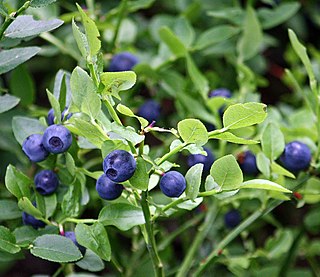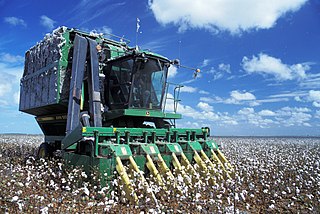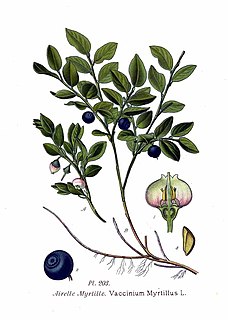
A berry is a small, pulpy, and often edible fruit. Typically, berries are juicy, rounded, brightly colored, sweet, sour or tart, and do not have a stone or pit, although many pips or seeds may be present. Common examples are strawberries, raspberries, blueberries, blackberries, red currants, white currants and blackcurrants. In Britain, soft fruit is a horticultural term for such fruits.

Vaccinium is a common and widespread genus of shrubs or dwarf shrubs in the heath family (Ericaceae). The fruits of many species are eaten by humans and some are of commercial importance, including the cranberry, blueberry, bilberry (whortleberry), lingonberry (cowberry), and huckleberry. Like many other ericaceous plants, they are generally restricted to acidic soils.

Lock picking is the practice of unlocking a lock by manipulating the components of the lock device without the original key.

Vaccinium vitis-idaea, the lingonberry, partridgeberry, mountain cranberry or cowberry, is a small evergreen shrub in the heath family Ericaceae, that bears edible fruit. It is native to boreal forest and Arctic tundra throughout the Northern Hemisphere, from Europe and Asia to North America. Lingonberries are picked in the wild and used to accompany a variety of dishes in Northern Baltoscandia, Russia, Canada and Alaska. Commercial cultivation is undertaken in the U.S. Pacific Northwest and in many other regions of the world.

Bilberries, or occasionally European blueberries), are a primarily Eurasian species of low-growing shrubs in the genus Vaccinium, bearing edible, dark blue berries. The species most often referred to is Vaccinium myrtillus L., but there are several other closely related species.

Finnish cuisine is notable for generally combining traditional country fare and haute cuisine with contemporary continental style cooking. Fish and meat play a prominent role in traditional Finnish dishes in some parts of the country, while the dishes elsewhere have traditionally included various vegetables and mushrooms. Evacuees from Karelia contributed to foods in other parts of Finland in the aftermath of the Continuation War.

Coffee production is the industrial process of converting the raw fruit of the coffee plant into the finished coffee. The coffee cherry has the fruit or pulp removed leaving the seed or bean which is then dried. While all green coffee is processed, the method that is used varies and can have a significant effect on the flavor of roasted and brewed coffee. Coffee production is a major source of income for 12.5 million households, most in developing countries.

Mechanised agriculture is the process of using agricultural machinery to mechanise the work of agriculture, greatly increasing farm worker productivity. In modern times, powered machinery has replaced many farm jobs formerly carried out by manual labour or by working animals such as oxen, horses and mules.
Whortleberry may refer to the berries of several plants of genus Vaccinium:

Lingonberry jam is a staple food in Northern European cuisine and otherwise highly popular in Central and Eastern Europe. Lingonberries grow on a short evergreen shrub in the Arctic tundra throughout the Northern Hemisphere from Eurasia to North America.

Vaccinium myrtillus or European blueberry is a species of shrub with edible fruit of blue color, commonly called "bilberry", "blaeberry", "wimberry", "whortleberry". It has much in common with the American blueberry. It is more precisely called common bilberry or blue whortleberry, to distinguish it from other Vaccinium relatives. Regional names include blaeberry (Scotland), urts or hurts, hurtleberry, huckleberry, myrtleberry, wimberry, whinberry, winberry, blueberry, and fraughan. Chromosome count is 2n =24.

A waste picker is a person who salvages reusable or recyclable materials thrown away by others to sell or for personal consumption. There are millions of waste pickers worldwide, predominantly in developing countries, but increasingly in post-industrial countries as well.

The harvesting of wine grapes (Vintage) is one of the most crucial steps in the process of wine-making. The time of harvest is determined primarily by the ripeness of the grape as measured by sugar, acid and tannin levels with winemakers basing their decision to pick based on the style of wine they wish to produce. The weather can also shape the timetable of harvesting with the threat of heat, rain, hail, and frost which can damage the grapes and bring about various vine diseases. In addition to determining the time of the harvest, winemakers and vineyard owners must also determine whether to use hand pickers or mechanical harvesters. The harvest season typically falls between August & October in the Northern Hemisphere and February & April in the Southern Hemisphere. With various climate conditions, grape varieties, and wine styles the harvesting of grapes could happen in every month of the calendar year somewhere in the world. In the New World it is often referred to as the crush.

Blueberries are perennial flowering plants with blue or purple berries. They are classified in the section Cyanococcus within the genus Vaccinium. Vaccinium also includes cranberries, bilberries, huckleberries and Madeira blueberries. Commercial blueberries—both wild (lowbush) and cultivated (highbush)—are all native to North America. The highbush varieties were introduced into Europe during the 1930s.

A stone picker is an implement to sieve through the top layer of soil to separate and collect rocks and soil debris from good topsoil. It is usually tractor-pulled. A stone picker is similar in function to a rock windrower ; a stone picker generally digs to greater depths to remove stones and rocks.
Order processing is the process or work-flow associated with the picking, packing and delivery of the packed items to a shipping carrier and is a key element of order fulfillment. Order processing operations or facilities are commonly called "distribution centers" or "DC's". There are wide variances in the level of automation associating to the "pick-pack-and-ship" process, ranging from completely manual and paper-driven to highly automated and completely mechanized; computer systems overseeing this process are generally referred to as Warehouse Management Systems or "WMS".

American Pickers is an American reality television series that premiered on January 18, 2010 on History, produced by A&E Television Networks in collaboration with Cineflix Media.

Vispipuuro, vispgröt/klappgröt/klappkräm or mannavaht is a sweet, wheat semolina (manna) dessert porridge made with berries, usually lingonberries. It is eaten in Finland, Sweden and Estonia. The semolina is cooked with the berries and also some kind of sweetener. Note that in Sweden, it's usually made by adding lingonberry cordial to the water, in which the semolina is cooked, as the texture is supposed to be smooth, so you don't want little bits of berries in the porridge. After the mixture has cooled down, the porridge is vigorously whipped to a light, mousse-like consistency. Alternatively, the pot the porridge was made in, can be put in the kitchen sink, partially filled with water and whisk it in there, so it cools down while being whisked with a hand mixer. The dessert is usually served with milk and optionally sugar. Other berries and fruit that can be used are redcurrants, cranberries, apricots, gooseberries and strawberries.

Vaccinium deliciosum is a species of bilberry known by the common names Cascade bilberry, Cascade blueberry, and blueleaf huckleberry.
2-Decenal (dec-2-enal) is an organic compound with the chemical formula of C10H18O. It exists as a pair of cis and trans isomers, (2E)-2-decenal and (2Z)-2-decenal. It is an oily, clear liquid under normal conditions, that may be yellow due to impurities. 2-Decenal is described as having a strong, waxy odor. It is found in animal food (in trace quantities), and is part of the essential oil of coriander. 2-Decenal is also used as a flavoring agent.


















